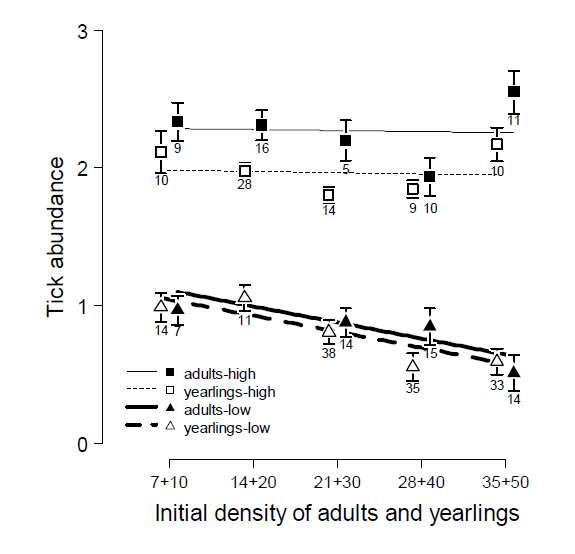
Ecological Archives E096-046-A4
Marianne Mugabo, Samuel Perret, Beatriz Decencière, Sandrine Meylan, and Jean-Franҫois Le Galliard. 2015. Density-dependent immunity and parasitism risk in experimental populations of lizards naturally infested by ixodid ticks. Ecology 96:450–460. http://dx.doi.org/10.1890/14-0524.1
Appendix D. Patterns of density dependence of tick abundance in weakly and highly infested lizards.
Fig. D1. Density dependence of tick abundance in weakly and highly infested lizards. Data are given as mean ± SE according to initial density of adults and yearlings. Numbers below error bars indicate sample size. We tested for a difference in the pattern of density dependence of tick abundance between weakly infested (i.e., with a tick abundance below the average of 4 ticks per individual obtained from abundance data collected at all density levels, n = 181 and included 57% of all males and 61% of all females) and highly infested (i.e., with a tick abundance above average, n = 122) individuals using generalized linear mixed-effects models as described in the main text. Fixed effects included a linear effect of density, an additive effect of sex and age class, an additive effect of "host type" (with "low" for abundance < 4 and "high" for abundance ≥ 4) and their first order interactions. We found that the effect of density on tick abundance depended on host type (density × host type: LRT = 8.12, P = 0.004). Among individuals with a tick abundance above average, abundance did not decrease with density (density slope on the log scale = -0.005 ± 0.039) while among individuals with a tick abundance below average, abundance decreased with density (density slope on the log scale = -0.181 ± 0.061). In addition, when host type was included in the analysis of abundance, sexes no longer differed significantly in average tick abundance (sex: LRT = 2.17, P = 0.14). Also, among highly infested hosts, yearlings were less infested than adults in average (yearling contrast on the log scale = -0.390 ± 0.084) while among weakly infested hosts, tick abundance was similar in adults and in yearlings (yearling contrast on the log scale = -0.037 ± 0.173; age class × host type: LRT = 4.26, P = 0.04). Similar patterns of density dependence were obtained when the average tick abundance per host used to determinate host type was estimated based on data collected at the intermediate density level (i.e., 2.75 tick per host) instead of data collected at all density levels. Estimates of regression lines were obtained from the minimum adequate model with log(tick abundance + 1) as response variable.